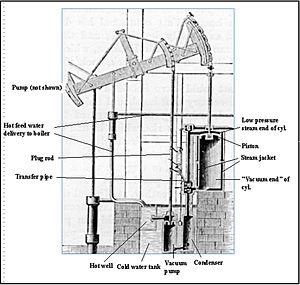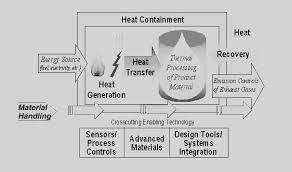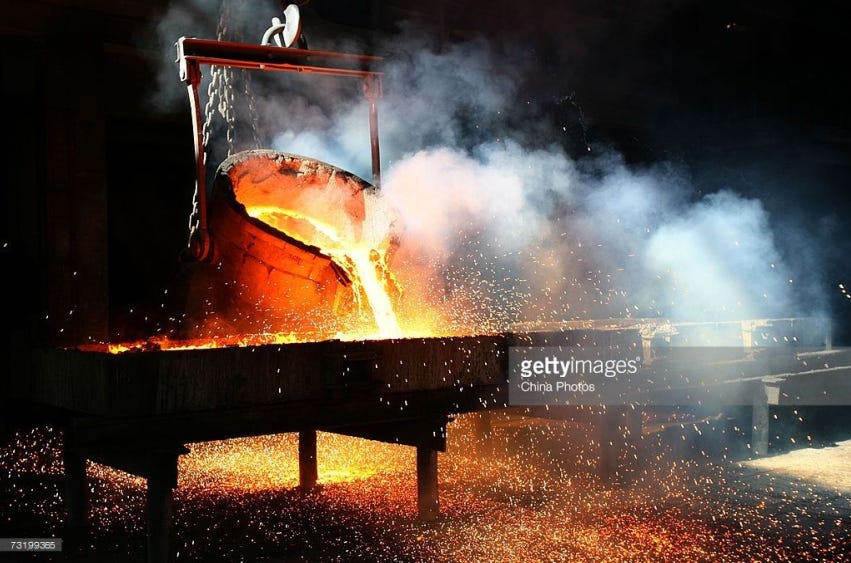Full Steam Ahead
When you can't make them see the light, make them feel the heat. Ronald Regan
The year 1776 was a pivotal year for the world, the formation of the United States, the birth of Capitalism via Adam Smith work The Wealth of a Nation, and The Steam Engine invented by James Watts simultaneously occurred. Now to be fair the steam engine was first commercialized in 1712 by Thomas Newcomen. James Watt made a critical improvement, by removing spent steam to a separate vessel for condensation, greatly improving the amount of work obtained per unit of fuel consumed. Both water and wind power could be unreliable as sometimes rivers could dry up during a drought or freeze during the winter and wind didn't always blow. Steam power allowed for factories to be located anywhere. It also provided reliable power and could be used to power large machines.
Steam is a fundamental component of manufacturing and process industries worldwide. Its importance continues to grow with the increasing global consumption and advancements in manufacturing. Steam boilers have become indispensable assets for ensuring high-quality manufacturing and maximizing productivity. Cogeneration plants exemplify this, as they generate steam and electricity concurrently, conserving resources and reducing emissions. By converting external mechanical energy into electrical energy, these plants produce steam in boilers, which then drives turbines to generate electricity. Therefore, steam plays a vital role in both processing operations and power generation.
Applications of Steam in Processing Plants:
Steam for Heating:
Steam is widely used for heating purposes due to its high efficiency, reliability, cost-effectiveness, and ease of use. It can be applied directly or indirectly.
Direct Heating: In direct heating, steam directly heats the product. Precision is crucial to ensure uniform heating, making it ideal for applications like pharmaceuticals and food processing.
Indirect Heating: Steam indirectly heats products without direct contact, often achieved through heat exchangers, cookers, or jacketed vessels.
Steam for Atomization:
Steam is essential for atomizing fuels into tiny particles in burners. This process ensures effective combustion by increasing the fuel's surface area, minimizing soot formation, and enhancing overall efficiency.
Steam for Drying:
Steam serves as an effective drying medium, eliminating moisture from products. It offers advantages over hot air, being cost-effective, easy to control, and safe, while also improving product quality and finishing.
Steam for Power Generation:
Steam is crucial in power generation through the Rankine Cycle. Superheated steam drives turbines, generating electricity. The steam is then condensed back into water and cycled through the boiler system for reuse. Its temperature and pressure directly impact power plant efficiency.
Steam for Sterilization and Disinfection:
Sterilization and disinfection are vital in ensuring clean and safe industrial environments. High-temperature steam is used in various industries like pharmaceuticals, food processing, and chemicals to sterilize process plants and equipment, maintaining product quality.
While steam itself is just a medium, its heat applications are essential. Industrial heat accounts for two-thirds of all industrial energy use and almost 20% of global energy consumption, according to the International Energy Agency (IEA). Heat is crucial for transforming raw materials into finished goods, with processes ranging from plastics and resins to chemicals and metals production. Despite this, industrial heating has often been overlooked in climate agendas, with heating processes (excluding steam generation) consuming nearly 17% of industry energy use. Fossil fuels provide 92% of this energy, further complicating the sector's decarbonization.
Coal and Natural Gas: The Backbone of Industrial Heating
Coal currently holds the title as the most common fuel source for industrial heating in China, the world's largest goods producer and exporter. According to risk assessment firm DNV, coal accounts for approximately 47% of the country's industrial heat used in manufacturing. However, DNV's energy transition outlook suggests that this share may increase to nearly 50% within the next decade before beginning to decline.
In contrast, natural gas dominates industrial heating in Europe and North America. DNV data reveals that natural gas is expected to account for nearly 44% of Europe's industrial heat by 2025. Meanwhile, North American industry is projected to remain heavily reliant on natural gas for heating, with a staggering 68% dependency forecasted through to 2050.
Looking ahead, natural gas is poised to overtake coal as China's primary fuel for industrial heating by around 2035. This shift reflects a global trend towards cleaner energy sources and stricter environmental regulations.
The reliance on coal and natural gas for industrial heating underscores the challenges of transitioning to cleaner energy alternatives. While natural gas is cleaner than coal in terms of emissions, both fossil fuels contribute to greenhouse gas emissions.
To get an understanding of how intertwin heat is to our modern economy lets turn up the heat-pun intended-and step into the kitchen.
Wind Turbines
Manufacturing wind turbines, ironically designed to reduce reliance on fossil fuels, involves an energy-intensive process at every step. Large trucks transport steel and other raw materials to the site, where earth-moving equipment clears paths to inaccessible high ground, and cranes erect massive structures, all powered by diesel fuel. Even freight trains and cargo ships transporting materials like cement, steel, and plastics contribute to this fossil fuel dependence.
For a 5-megawatt turbine, steel alone averages 150 metric tons for reinforced concrete foundations, 250 metric tons for rotor hubs and nacelles (housing the gearbox and generator), and 500 metric tons for towers. If wind-generated electricity were to supply 25 percent of global demand by 2030, requiring about 30 petawatt-hours, the aggregate installed wind power of about 2.5 terawatts would necessitate roughly 450 million metric tons of steel, not including metal for towers, wires, and transformers.
Steel production is energy-intensive, involving processes like smelting iron ore in blast furnaces with coke made from coal and infusions of powdered coal and natural gas. To produce the steel required for wind turbines by 2030, more than 600 million metric tons of coal equivalent would be needed.
Wind turbine blades, made from glass-fiber-reinforced epoxy or polyester resins, are produced using processes dependent on fossil fuels. The final fiber-reinforced composite embodies a significant amount of energy, equivalent to about 170 gigajoules per metric ton. To achieve 2.5 terawatts of installed wind power by 2030, an aggregate rotor mass of about 23 million metric tons, requiring about 90 million metric tons of crude oil equivalent, would be needed.
Despite the potential benefits, wind turbines depend heavily on specific fossil energies for production, installation, and maintenance. Most of these energies, including coke, coal, petroleum coke, naphtha, natural gas, and diesel, lack non-fossil substitutes available on a large commercial scale. Thus, the entire process, from steel production to turbine installation, relies on fossil fuels.
While wind turbines can generate clean energy once operational, their production has significant environmental costs, largely reliant on fossil fuels.
Semiconductors
In a piece titled Why do we burn Coal and Trees to Make Computer Chips and Solar Panels, Dr. Thomas A. Troszak does a wonderful job at explain the energy resources and process used to make semiconductors and solar panels, it’s a fantastic read.
Since the early 1900s, silicon “metal” is reduced from quartz using carbon in submerged-arc furnaces, each powered by up to 45 megawatts* of electricity. (Fig 1,2). *45 megawatts (MW) is enough for a small town (about 33,000 homes).
Figure 1
Figure 2. Diagram of a silicon smelter showing the three giant carbon electrodes that provide arc temperatures > 3,000oF for smelting quartz into “metallurgical grade” silicon (mg-Si) using carbon as a reductant.[26] (John Wiley and Sons, Ltd.)
Burning carbon to make silicon
- Elemental silicon (Si) can’t be found by itself anywhere in nature. It must be extracted from quartz (SiO2) using carbon (C) and heat (from an electric arc) in the “carbothermic” (carbon+heat) reduction process
Figure 3. Pouring liquid metallurgical grade (~99% pure) silicon into molds, to cool into silicon “metal”. (Getty)
Processing of silicon requires a massive input of energy from burning fossil fuels
Fossil fuels are used generate electricity for the polysilicon, ingot, wafer, cell, and module production steps shown.
Figure 4.
Industrial Process Heating and Energy Consumption
Industrial process heating accounts for a significant portion of energy consumption, ranging from 15% to 85% in various applications. Factors such as process temperature, equipment design, and heat recovery systems greatly influence the energy efficiency of these systems. Therefore, optimizing industrial process heating presents significant opportunities for energy savings.
Process heating equipment operates over a wide temperature range, from 300°F to as high as 3000°F, consuming substantial amounts of energy. In fact, energy costs for process heating represent 2% to 15% of a product’s total cost. In the U.S. industry, process heating is the largest contributor to direct energy use during manufacturing.
Across industries, process heating is used for various operations such as fluid heating, calcining, drying, heat treating, metal heating, melting, smelting, curing, and forming. Different temperature requirements demand different technologies and fuels. For example, while heat pumps efficiently deliver low-temperature heat, high-temperature processes are dominated by gas boilers.
One of the challenges in decarbonizing industrial heating is the inertia and complexity of existing systems. Industrial heat systems are often designed for long lifetimes and tailored to specific processes, making change difficult. Transitioning to more sustainable heating methods involves significant capital investments, operational disruptions, and technical risks.
Industrial Heat Demand and Its Implications for Fossil Fuels
Industrial heat demand is projected to expand by 16% (equivalent to +17.6 exajoules) globally during the period 2023-2028, with China and India accounting for more than half of this growth. Heat accounted for almost half of the total final energy consumption and 38% of energy-related CO2 emissions in 2022. Annual heat consumption expanded by 6% globally over the period 2017-2022. The heat sector alone will consume more than one-fifth of the remaining carbon budget for an even chance to limit global temperatures to the scientifically recommended 1.5-degree Celsius benchmark.
If fossil fuel use is not contained, the heat sector alone in 2023-2028 could consume more than one-fifth of the remaining carbon budget for an even chance to limit global warming to 1.5°C, according to the IEA.
Recent energy and climate policies seem to overlook a key point about the energy complex. It's more than just transportation and electrical generation, both of which have their own challenges. This miscalculation could hand the economic keys to countries willing to exploit this situation. Heavy industrial countries, led by China, India, Indonesia, and Vietnam, have been expanding their fossil fuel capacity under the guise of energy security. In reality, this expansion is to ensure the stability of their manufacturing sectors.
These countries are home to the manufacturing and refining of all the green technology and electrical components required to decarbonize the developed world’s economy. Yet, the irony is that without the fossil fuels needed to generate the heat, many of the components essential for green technology would not be available. This means that the goals of the developed world could not be achieved. This is why the talk of replacement or reduction of fossil fuels usage is misguided.
Seeing this, and armed with the weight of the purse and pen, developed governments are trying various workarounds for this geopolitical complexity. They are exploring options such as using nuclear energy to generate heat via Small Modular Reactors (SMRs) and electrical heating. However, with very few exceptions—such as Norway and Iceland, where the electrical grid is primarily based on hydro and geothermal power—these efforts have only led to an explosion in commodity prices. This is caused by artificially inflating demand, resulting in price increases, i.e., inflation.
In conclusion
Given the absence of viable substitutes for industrial heating and shortages of many industrial commodities crucial for green and semiconductor technology, countries willing to exploit this situation stand to gain in the political sphere. Which will shape policies that ensure continued profit for fossil fuel producers and providers of these commodities for years to come.













Excellent 👍 concise educational article, and thanks for the shout out re. silicon production!
It is interesting - and difficult to believe - that the EU will double its use of geothermal between now and 2050 as illustrated in the chart that contains the projections for industrial heat. I wonder if they mean conventional geothermal - like the Larderello facility - or the ground-sourced heat-pump-based technology. In any event, geothermal is widely considerd "free" --- so this begs the question why haven't the EU already emabarked on this path?